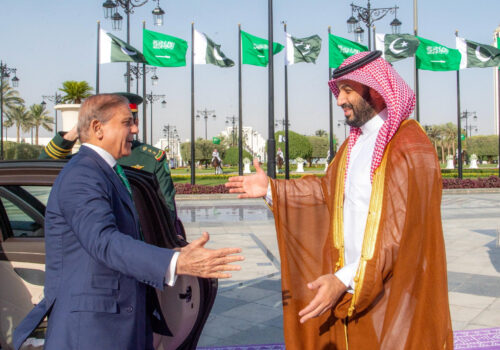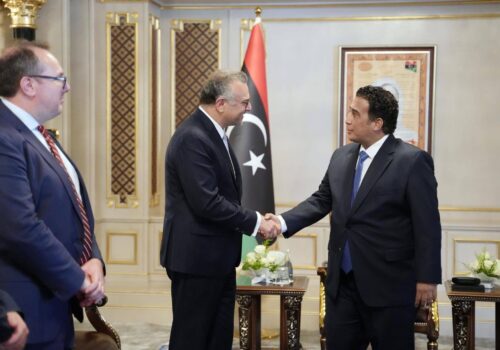The Trump-MBS meeting comes at a pivotal moment for Vision 2030
Saudi Crown Prince Mohammed bin Salman’s visit to Washington will likely include a series of announcements of commercial and defense-related agreements between the kingdom and the United States. Woven into every discussion, however, will also be an issue that remains central to the prince’s vision for Saudi Arabia—the ambitious economic transformation plan known as Vision 2030, which seeks to diversify the country’s economy, increase private-sector participation, and reduce dependency on oil. Today, Saudi Arabia faces the threat of regional instability preventing the realization of Vision 2030—and it thinks the United States can help.
Saudi leadership is looking to bring in more international investors, keep supply chains running smoothly, and maintain a consistent stream of visitors to the country. Meanwhile, US policymakers are hoping for a calmer Middle East and a Saudi Arabia that’s both stronger and able to weather challenges. Both sides understand that Vision 2030 now depends on what happens outside the kingdom’s borders as much as on the reforms taking place within.
Related reading
The timing matters because Vision 2030 has reached a more demanding stage. The kingdom has made clear gains in entertainment, tourism, public administration, and industry. At the same time, its most visible projects face delays, rising costs, and heavier reliance on public financing. Experts have documented higher construction expenses, shortfalls in foreign investment, and repeated capital injections into regional development projects such as Neom—all of which place pressure on state finances and investor confidence.
These challenges explain why Saudi policymakers are increasingly sensitive to regional shocks—including conflicts between Israel and Iran, increased maritime threats in the Red Sea, and political instability in the Levant—that can slow progress or weaken investor trust. Vision 2030 is now shaped not only by domestic choices but by the stability of the neighborhood around Saudi Arabia.
Regional instability
Increased attacks on commercial vessels in the Red Sea from Yemen’s Houthi rebels in recent years show how regional instability directly affects Vision 2030. The Houthis continue to disrupt global supply chains and raise insurance premiums for vessels heading toward the Suez Canal. The campaign of attacks has prompted companies, such as Maersk, to divert ships around the Cape of Good Hope. These changes increased transit times and created uncertainty in the logistics networks that Saudi Arabia hopes to anchor along its western coast. Tourism in the Red Sea has also slowed as travelers reassessed security conditions. These trends matter because the western coastline sits at the center of the kingdom’s tourism and infrastructure plans.
Sudan’s conflict reinforces these pressures. The war has destabilized a region that matters for Saudi food supplies, investments across Africa, and security around Port Sudan’s shipping lanes. Gulf states have considerable leverage in Sudan because of their financial and political ties, yet competing agendas have complicated efforts to reach a durable peace. Analysts warn that the conflict is reshaping Red Sea security and that instability on land is spilling over into the maritime environment. For Saudi Arabia, prolonged fighting threatens the long-term viability of coastal tourism and logistics projects that rely on predictable security conditions.
With Israeli strikes in Gaza continuing and Hamas yet to disarm, the Gaza peace plan continues to face strong headwinds. This unsettles global markets—including in the energy sector—and harms tourism in this region. Riyadh has signaled readiness to support postwar stabilization, but any substantial Saudi commitment hinges on governance reforms in Gaza and a recognized Palestinian political authority.
The Twelve Day War between Iran and Israel this June was a reminder of how quickly this region can drift into a bigger conflict, as well as Saudi Arabia’s vulnerability to spillovers. Saudi officials see the renewed Iran-Israel tensions as a direct threat to the energy security and investment climate Vision 2030 relies on. Cognizant of Israel’s strike in Qatar last September as well as Iran-supported strikes on commercial facilities in Saudi Arabia in 2019, Riyadh likely views its decent relationships with both Israel and Iran as helpful for reducing miscalculation and maintaining communication. However, they do not replace Riyadh’s need for sustained US engagement to deter a wider confrontation.
Saudi Arabia’s stabilizing role and its alignment with US interests
Saudi Arabia’s regional diplomacy has expanded as Vision 2030 has taken shape, positioning Riyadh as a stabilizing force in the region. It continues to play a role in mediating the decade-long conflict in Yemen while supporting Yemen’s government in Aden. Along with the United States, Egypt, and the United Arab Emirates, Riyadh pursues an end to the war in Sudan via the Quad mechanism and remains an active partner in supporting post-Assad Syria through its transition. These diplomatic and development efforts not only support stabilization efforts but ultimately create the conditions Vision 2030 requires for Saudi Arabia’s own economic transformation.
This approach is also visible in emerging Saudi defense policy, which centers on deterrence, diversification of partnerships, and the development of domestic defense-industrial capacity. Riyadh believes that security cannot be outsourced and is seeking a more structured security relationship with the United States. This aligns with a wider trend in the Gulf, where Washington and its partners are exploring a more formal regional security architecture built around burden sharing, defined guarantees, and joint operational planning.
Washington wants secure sea lanes, an energized market, and partners in the Middle East capable of preventing or resolving conflicts without the expectation of significant US resources or military support. A Saudi Arabia that achieves an economic transformation is a better, more reliable partner in international diplomacy for US national security needs. This week’s visit by MBS reflects this recognition of shared priorities for Riyadh and Washington: The United States sees an economic transformation unfolding in Saudi Arabia, and Saudi Arabia sees the United States as a partner critical for creating a stable regional context in which its Vision 2030 is possible.
For the Trump administration, stability in the Middle East is essential to the regional strategy it is building. The White House is placing political and economic bets that a partnership with Saudi Arabia results in increased energy security, investment partnerships, and conflict-ending diplomacy in places like Gaza, Yemen, and Sudan.
Frank Talbot is a nonresident senior fellow with the North Africa Initiative at the Atlantic Council’s Rafid Hariri Center & Middle East programs. Previously, he served in the Department of State supporting stabilization initiatives in the Middle East and North Africa.
Further reading
Wed, Oct 16, 2024
Vision 2030 has done wonders for women. But there’s still room to enhance their economic roles in Saudi Arabia.
MENASource By
Saudi Arabia’s progress under Vision 2030 is impressive, but the journey is not yet over.
Fri, Sep 26, 2025
The Saudi-Pakistan defense pact highlights the Gulf’s evolving strategic calculus
MENASource By
In Riyadh’s multi-aligned policy, signing a mutual defense deal with Pakistan is complementary, not alternative, to US security guarantees.
Fri, Oct 3, 2025
US, Italy, and Turkey alignment could push the needle in Libya
MENASource By
The US, Italy and Turkey can—through balanced diplomacy—reinforce the economic opportunities presented by institutional unification in Libya.
Image: FILE PHOTO: Saudi Crown Prince Mohammed Bin Salman announces a zero-carbon city called "The Line" to be built at NEOM in northwestern Saudi Arabia, January 10, 2021. Bandar Algaloud/Courtesy of Saudi Royal Court/Handout via REUTERS ATTENTION EDITORS - THIS PICTURE WAS PROVIDED BY A THIRD PARTY//File Photo





